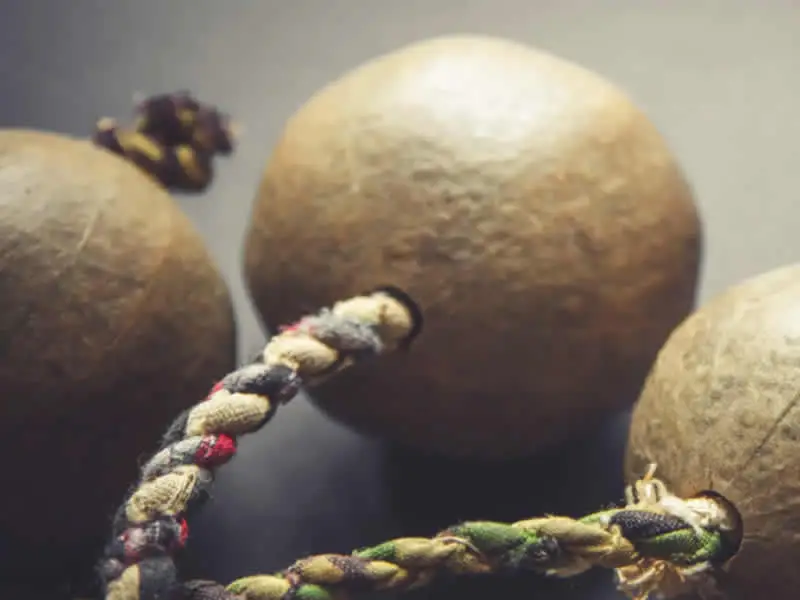In this article, I will explore an intriguing shaker instrument that features a distinctive two-ball string design.
Known for its rhythmic capabilities and musical versatility, this percussion instrument is a must-have for musicians and enthusiasts alike.
Content
How to Use the Kashaka
To use the kashaka, hold one gourd in your hand and swing the other gourd from side to side around the hand.
This will create the characteristic “clack” sound. By varying the speed and intensity of the swings, you can create different rhythms and accents.
The kashaka can be used to enhance rhythm in music performances of various genres and styles. It can be played in conjunction with other instruments or as a standalone percussion instrument.
The versatility of the kashaka allows musicians to add unique rhythmic elements to their compositions and improvisations.
It is commonly used in traditional and contemporary African music, as well as in world music and fusion genres.
Playing the kashaka can enrich the overall musical performance by adding a distinctive sound and rhythm enhancement.
Whether you are a professional musician or just starting to explore percussion instruments, the kashaka is a valuable tool that can bring an exciting dynamic to your musical repertoire.
Manufacturing Methods of the Kashaka

In order to produce the distinctive sound of the kashaka, careful manufacturing methods are employed.
The balls of the kashaka are crafted from hollow gourds, primarily sourced from the Oncoba spinosa tree.
Once these gourds naturally dry and fall from the trees, they are collected by local children who assist in the manufacturing process.
Traditionally, two main methods are used to attach the gourd balls to the string. The first method involves creating a single hole in the bottom of one gourd.
The knotted end of the string is then inserted into the hole, while the other end of the string is attached to a stick that is securely glued to the gourd. This method ensures stability and durability during play.
In the second method, a hole is made on both the top and bottom of each gourd. The string is carefully threaded through the holes, and a knot is tied on the outside of the gourds.
This method allows for adjustability, as the knot can be easily moved up or down the string to accommodate different hand sizes and playing preferences.
This commitment to traditional manufacturing methods ensures the authenticity and quality of the kashaka, allowing players to experience the true essence and sound of this unique percussion instrument.
Finding the Right Size Kashaka
When choosing a kashaka, it’s important to find the right size that suits your needs and preferences.
Consider two factors: the string length and the pod size. By taking these into account, you can ensure a comfortable and optimal playing experience.
The correct string length can be determined by measuring the width of your palm at the base of your fingers and adding 1cm.
This measurement will provide a suitable grip for the kashaka, allowing you to play with ease and precision.
Pod size, on the other hand, is more of a personal preference. Smaller pods tend to produce quieter and more shimmery sounds, making them ideal for those with small hands.
Larger pods, on the other hand, create a more percussive sound and are better suited for individuals with larger hands. If you’re unsure about the size, consider opting for medium-sized pods, which offer a good balance between comfort and volume.
| Size | Description |
|---|---|
| Small | Quiet and shimmery sound |
| Medium | Balance between comfort and volume |
| Large | More percussive sound |
If you’re uncertain about the size that suits you best, don’t worry! When ordering a kashaka, you can provide your palm measurements and hand size to the seller.
They’ll be able to assist you in choosing the perfect kashaka that matches your specific requirements.
Aslatua – An Alternative Name for the Kashaka
The kashaka, a traditional instrument known for its rhythmic capabilities, also goes by the alternative name “aslatua” in the vibrant country of Ghana.
Pronounced as “us-la-twa,” the aslatua has its roots deeply embedded in Ghanaian culture.
Crafted from hollowed gourds sourced from the indigenous Swawa tree, these unique instruments are filled with orange pebbles sourced from the iron-rich soil of the Sahel region.
Passed down through generations, the aslatua is played by holding one gourd in the palm while swiftly swinging the other gourd around, producing a diverse range of sounds and rhythms.
It is customary to play the aslatua in pairs, with one instrument held in each hand, enabling musicians to create complex polyrhythms that are characteristic of traditional Ghanaian music.
The aslatua holds great significance in Ghanaian culture, not only as a musical instrument but also as a symbol of heritage and tradition.
Its melodic resonance can be heard in various ceremonial events and cultural gatherings throughout the country, embodying the spirit and soul of Ghana.
The unique rhythmic patterns created by the aslatua add a distinct flavor to traditional Ghanaian music, captivating listeners with their intricate and hypnotic beats.
Its versatile nature allows it to seamlessly blend with other traditional instruments, creating a harmonious ensemble that truly reflects Ghana’s rich musical heritage.
With its roots deeply intertwined with Ghanaian culture, the aslatua serves as a powerful reminder of the country’s rich history and artistic expression.
Whether played by skilled musicians or curious newcomers, the aslatua offers a captivating and immersive musical experience.
Its rhythmic melodies and cultural significance continue to mesmerize audiences and keep Ghana’s musical traditions alive.
So, if you ever find yourself in Ghana, don’t miss the opportunity to witness the enchanting sounds of the aslatua, a traditional instrument that truly embodies the spirit of this remarkable country.
